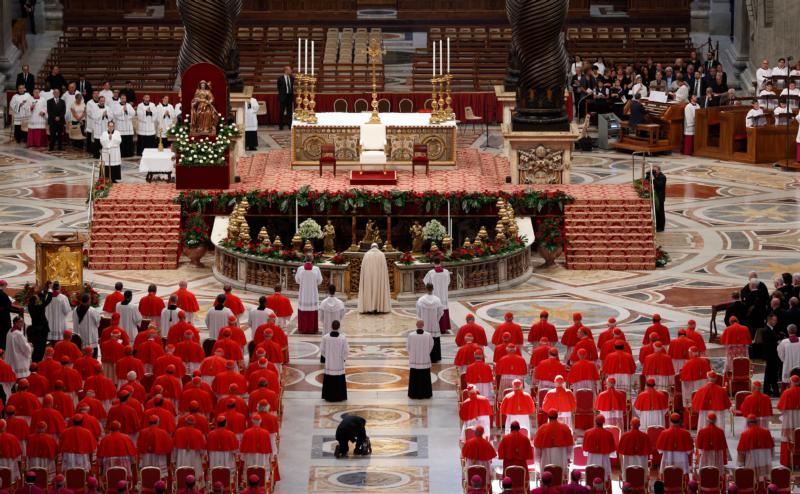
Pope Francis prays as he arrives for a 2017 consistory in St. Peter’s Basilica at the Vatican. The pontiff announced May 20 that he will create 14 new cardinals at a June 29 consistory. (CNS photo/Paul Haring)
VATICAN CITY (CNS) — Although it is not unusual for a pope to set aside temporarily the limit of 120 cardinals under the age of 80, Pope Francis has done so in a way that could last for more than a year.
The pope announced May 20 that he would create 14 news cardinals June 29; 11 of them are under the age of 80 and would be eligible to enter a conclave to elect a new pope.
In early June, Cardinal Angelo Amato will celebrate his 80th birthday, which will drop the number of electors to 114. Three weeks later, the batch of new cardinals will raise the number of potential electors to 125.
[hotblock]
Cardinal Amato is the last cardinal to turn 80 in 2018. And it will take until July 31, 2019, for another five cardinals to age out.
Confirming the limit of 120 electors set by Blessed Paul VI, St. John Paul II wrote in “Universi Dominici Gregis,” his rules for a conclave, that “the maximum number of cardinal electors must not exceed 120.”
That led one major news agency to report, “If a conclave has to be called before any other cardinal turns 80, the electors would have to draw lots to see which five men would be barred from the gathering.”
Conclaves don’t happen that often and none in recent history took place when there were more than 120 eligible electors. But the idea of a lottery for entrance into the Sistine Chapel, where the voting would take place, led many people to scratch their heads.
After all, “Universi Dominici Gregis” and the changes made to it by Pope Benedict XVI in 2013 both strongly state: “No cardinal elector can be excluded from active or passive voice in the election of the supreme pontiff.”
A pope, as the supreme legislator of the Catholic Church, can set aside the limit of 120 potential electors. But doing so does not change the no-exclusion clause.
And while a year may be a long time to exceed the 120 limit, exceeding it by five cardinals is minor compared to what St. John Paul II did in February 2001. Creating 44 new cardinals — the biggest batch ever at one consistory — the pope raised the number of cardinal electors to 135.
[tower]
St. John Paul created another 30 cardinals in 2003, bringing the number of electors back up to 135 once again. But, by the time he died in 2005, only 117 were under 80, and two of those were too ill to participate in the conclave that elected Pope Benedict.
The Polish pope’s mega-consistories broadly expanded the international — in other words, the catholic — identity of the College of Cardinals. It is a process that continues.
Pope Francis’ latest cardinals-designate include churchmen from five countries not currently represented in the College of Cardinals. But each of those countries — Bolivia, Pakistan, Japan, Madagascar and Iraq — has had a cardinal in the recent past.
With the edition of the new cardinals, the group of electors will represent 67 nations. The cardinals who elected Pope Francis in 2013 came from 48 countries.
The number of Italians with a red biretta, the cardinal’s three-cornered hat, still far exceeds those of any other nation, and Pope Francis is about to add three more to their number.
The day before the consistory, 18 Italians would be eligible to enter a conclave — 19 if you count Cardinal Mario Zenari, the Italy-born nuncio to Syria, who Pope Francis made clear was chosen to represent Syria. Still, in the 2013 conclave that elected Pope Francis, 28 were Italian.
The country with the next-highest number of cardinal electors is the United States, which has 10 cardinals under the age of 80.
At a Mass with the College of Cardinals in 2017, a Mass marking his 25th anniversary as a bishop, Pope Francis said that the Catholic Church is not a “gerontocracy” ruled by old men; “we aren’t old men, we are grandfathers.”
But his choices for the June consistory do very little to lower the average age of the group of electors. Only one, Cardinal-designate Konrad Krajewski, the papal almoner, is still in his 50s. He is 54. Cardinal Dieudonne Nzapalainga of Bangui, Central African Republic, is 51 years old and still will be the youngest cardinal once the consistory is over.
On June 28, there will be 114 electors with an average age of 71 years, 11 months and one day. After the consistory the next day, there will be 125 electors with an average age of 71 years, eight months and 20 days.
The cardinals who elected 58-year-old Cardinal Karol Wojtyla — St. John Paul II — in 1978 had an average age of 67.
PREVIOUS: Australian archbishop, convicted of abuse cover-up, stepping aside
NEXT: Vatican bank sees profit while making ethical investments, report says



Share this story